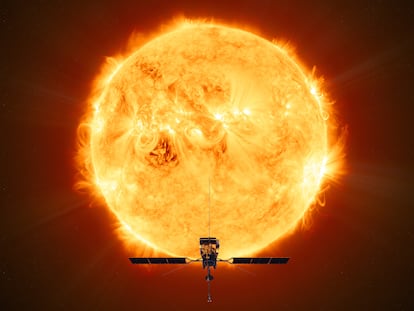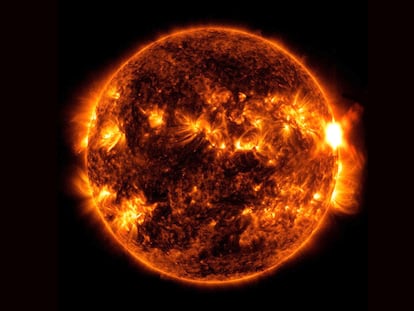The Chapman-Silverman event, the most intense geomagnetic storm ever recorded brought auroras to the Sahara
The impact of a solar eruption in 1872 disabled the telegraph service and for many was a divine herald of the end of the world
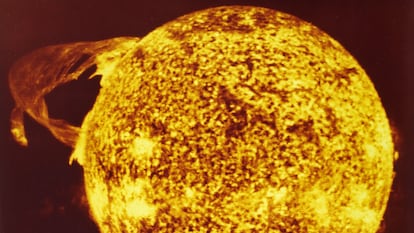
“At dawn on Sunday this beautiful celestial phenomenon appeared, with the masses making a thousand comments about its radiance. Despite the northern lights having been studied extensively, none of the astronomers have been able to specify the causes of their appearance. However, this time, there is no shortage of those who have said that it presaged the death of the dynasty of D. Amadeo and great gunpowder festivals in the next spring,” said a brief from El Eco del Bruch on February 11, 1872. The text from the Carlist newspaper referred to a series of dawns seen the previous Sunday, 4 February. The editor took advantage of the impact it had on the people to attack Amadeo I, the king installed by the liberals. Now, 151 years later, the review of hundreds of historical records like this one has made it possible to estimate the intensity of the phenomenon that caused such a spectacle. The review’s authors have called it the Chapman-Silverman event, and, they say, it was the most intense ever recorded.
Between 9:00 and 10:00 Coordinated Universal Time (UTC) on February 3, 1872, a coronal mass ejection occurred from a set of sunspots. At 14:27 UTC the next day, a solar storm shook the Earth’s magnetic field. The incursion was such that it left the telegraph service of almost the entire planet out of service or with serious operating problems. The physicist Raoul-Pierre Pictet, recognized for his work on the liquefaction of gases, was in Cairo, Egypt, in February 1872 and wrote: “I returned from the telegraph [office] where I collected the following information about the electrical phenomena that occurred yesterday afternoon ... it was difficult to communicate with Khartoum ... The devices were chattering on their own ... Ground currents prevented service and the employees were totally confused.” Meanwhile, in the Popular Scientific Chronicle by the Spanish engineer Emilio Huelin an article reads: “The disturbances that occurred in the telegraph lines were generally perceived at the same local time in Italy, France, Germany, and America.”
Pictec’s account from Egypt is one of the documents compiled by a group of researchers led by Hisashi Hayakawa, a scientist at Nagoya University, Japan, and veteran researcher Sam Silverman, who died before the results of his work were published. The Pictec text continues the story: “Yesterday afternoon, the Cairo office received a dispatch asking what the large red glow that was seen on the horizon was and suspecting a large fire. The telegraph line does not continue further south, beyond Khartoum, but it is probable that this aurora was also seen as far as Gondokoro, at 5° north latitude.” It is not strange that in almost all accounts an aurora is described in reddish tones. The color of the aurora depends on the elements such as oxygen, hydrogen, or nitrogen in the atmosphere with which the solar particles interact. That red shift helps confirm that the aurora was seen very close to the equator.
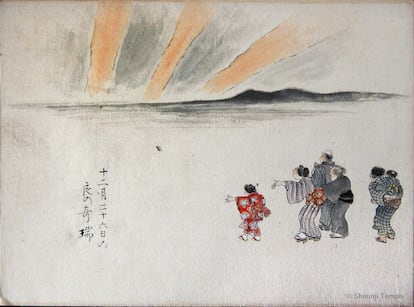
Hayakawa and other scientists find it hard to believe that an aurora borealis descended as far as Gondokoro, in southern Sudan and almost five degrees from the equator. Nothing like this has ever been recorded. The Earth, spinning with its iron core, is a gigantic magnet that generates its own magnetic field. The magnetosphere protects the planet and all the life on it from solar wind radiation, but the shield is thicker closer to the equator. Therefore, under normal conditions, auroras only occur at the poles or the higher latitudes of the globe. But if a solar storm arrives with sufficient intensity, they can occur in mid-latitudes, in central Europe, North America, or central Asia. But for them to go beyond the Sahara they must be especially intense.
“They were also seen in Spain [and Portugal], including in Cádiz, the Azores, and the Canary Islands,” says Hayakawa, the first author to quantify what happened on February 4, 1872, in this research published in The Astrophysical Journal. In the Annals of Puerto de la Cruz (Tenerife), compiled by José Agustín Álvarez Rixo, from the University of Las Palmas de Gran Canaria, you can read a brief line: “February 4. The first night “Aurora borealis was perceived to the north-northwest.” The next day’s edition, the federal republican newspaper published in Barcelona, La Independencia, reported: “Yesterday, around half past five, a beautiful northern lights appeared that caught the public’s attention and in particular those knowlegeable about these phenomena. At first it formed an arc that extended (sic) from Northwest to Northeast, extending (sic) at times towards the zenith.” If so, those auroras were not seen on the horizon (as happened in the Carrington event of 1859, which was one of the largest in history) but over the Spaniards’ heads.
José Ribeiro, a secondary education teacher at the Henrique Medina school in Esposende (Portugal) and co-author of the research, has compiled most of the Portuguese and Spanish records used by Hayakawa and Silverman. Although the majority limit themselves to collecting the phenomenon or using it to attack, as the Eco del Bruch journalist did, Ribeiro highlights that “according to the newspaper articles, some people feared war or the end of the world.” This could have contributed, he adds, “to the fact that in October 1870 another great aurora borealis was observed that coincided with the Franco-Prussian War and the political instability that was experienced in Spain at that time.” Shortly after, King Amadeo abdicated, the First Spanish Republic was proclaimed and the Carlist wars resumed.
Hayakawa and around twenty experts on these events have relied on these chronicles to make a map of how far the auroras of the Chapman-Silverman event reached. The logic behind this is that, the closer to the equator it was observed, the greater its intensity must have been. If the northern lights were seen in Tobago in the Caribbean, Sudan, and southern India, and the southern lights were seen as far north as Madagascar and Australia, the geomagnetic storm must have been one of the most intense. But the definitive proof must be provided by the observatories that monitor the sun and the magnetic fields scattered across the planet. There weren’t as many in the 19th century as there are today, which made the search more difficult. But in 1872 there was one in Colaba, across the causeway from Bombay (Mumbai), India, set up decades earlier by the British. The magnetogram it recorded from that impact shows a Dst (storm disturbance time) value of — 834 nanoteslas (nT). This value is almost double that recorded by the storm of February 1989, the most intense aurora in the electronic era. Until now, the two largest ever recorded were the Carrington event, in 1859, and the New York Central Station event, in 1921, named for the impact it had on New York City. The Chapman-Silverman event had an even lower Dst value. “This event was at least comparable or even more extreme than the Carrington storm of 1859,” Hayakawa maintains.
Víctor Manuel Sánchez is a professor of Earth Physics at the University of Exremadura and has carried out research on dozens of historical geomagnetic storms. Regarding the Dst index, he explains that it measures the disturbance in the magnetosphere: “When a solar intrusion occurs, there is a depression in the magnetic field.” Sánchez adds that currently, “the Dst index is measured using four observatories as close as possible to the equator; in 1872, they only had the Colaba magnetogram.” This leads the scientist to consider it risky to affirm that the Chapman-Silverman was larger than the Carrington, “but it is in the same order of magnitude,” he concedes. However, both he and Hayakawa, with whom he has worked on several occasions, concur that “the auroras were observed further towards the equator than those produced during the Carrington event.”
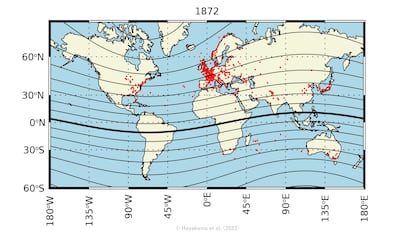
The only electromagnetic-based technology that humans had invented in both 1859 and 1872 was the telegraph. Electric lighting, telephone, radio networks, and electronics were yet to come. Not to mention television, satellites, and the internet. “A storm as intense as those would disrupt power grids, communications systems, and satellite operations. As they now form the basic infrastructure of our civilization, our lives could become a little more uncomfortable than usual,” Hayakawa recalls. Earlier this year, “a minor geomagnetic storm disabled about forty Starlink satellites [Elon Musk’s constellation], the Chapman-Silverman storm was at least one order of magnitude larger than the latter,” the Japanese scientist says.
The expert in space meteorology from the University of Alcalá de Henares, María Elena Sáiz, details what happens during an event of this nature: “Three types of things occur in a solar storm. One is electromagnetic radiation, which takes between seven and eight minutes to reach the Earth.” Its impact, in the ionosphere, affects radio waves, which use this layer to propagate. “Another element is solar energetic particles. When the flare occurs, one of its products are very energetic particles.” They are different from the solar wind constantly blowing from the star. “And then there are what we call coronal mass ejections. In addition to the flare, solar plasma is expelled and that is what impacts the Earth’s magnetosphere, sending particles into the magnetosphere.” A document from NOAA, the United States’ National Oceanic and Atmospheric Administration, estimated the amount of plasma ejected during a storm of this class at more than one billion tons.
“When the magnetic field changes and the faster it changes, the more significant the effect is,” says Sáiz. During the storm, “what we call geomagnetically induced currents are produced and the entire Earth is a conductor,” she explains. These currents can enter through the neutrals of all types of electrical transformers. “There are more harmonics, instabilities occur in the system and since it is a connected network, it is transferred to high voltage stations and substations. At a given moment, they may be overwhelmed.” Beyond electricity (although almost everything depends on whether there is a current) there would be problems in communications, the propagation of radio waves, and connections to satellites. And beyond humans, there is increasing evidence of the impact of these events on animal life, especially in species that use the magnetic field to orient themselves, such as birds or cetaceans. In fact, some studies have already linked events such as Chapman-Silverman with some of the strandings of whales and dolphins.
Sign up for our weekly newsletter to get more English-language news coverage from EL PAÍS USA Edition
Tu suscripción se está usando en otro dispositivo
¿Quieres añadir otro usuario a tu suscripción?
Si continúas leyendo en este dispositivo, no se podrá leer en el otro.
FlechaTu suscripción se está usando en otro dispositivo y solo puedes acceder a EL PAÍS desde un dispositivo a la vez.
Si quieres compartir tu cuenta, cambia tu suscripción a la modalidad Premium, así podrás añadir otro usuario. Cada uno accederá con su propia cuenta de email, lo que os permitirá personalizar vuestra experiencia en EL PAÍS.
¿Tienes una suscripción de empresa? Accede aquí para contratar más cuentas.
En el caso de no saber quién está usando tu cuenta, te recomendamos cambiar tu contraseña aquí.
Si decides continuar compartiendo tu cuenta, este mensaje se mostrará en tu dispositivo y en el de la otra persona que está usando tu cuenta de forma indefinida, afectando a tu experiencia de lectura. Puedes consultar aquí los términos y condiciones de la suscripción digital.
More information
Últimas noticias
ChatGPT fails the test: This is how it endangers the lives of minors
The late consecration of women artists in their 90s
The Florida Keys tourist paradise is besieged by immigration agents: ‘We’ve never seen anything like this’
The latest scam on WhatsApp behind the legal dream: using immigration status as bait
Most viewed
- Families demand repatriation of bodies of Colombians who died in Ukraine: ‘This war is a slaughterhouse for foreigners’
- The low-cost creative revolution: How technology is making art accessible to everyone
- Liset Menéndez de la Prida, neuroscientist: ‘It’s not normal to constantly seek pleasure; it’s important to be bored, to be calm’
- Christian Louboutin: ‘Young people don’t want to be like their parents. And if their parents wear sneakers, they’re going to look for something else’
- ‘El Limones’ and the growing union disguise of Mexican organized crime

